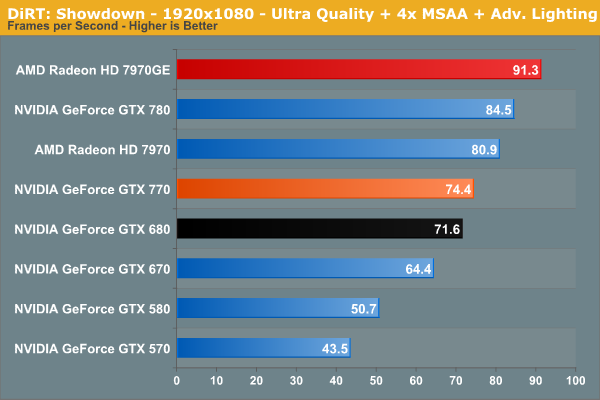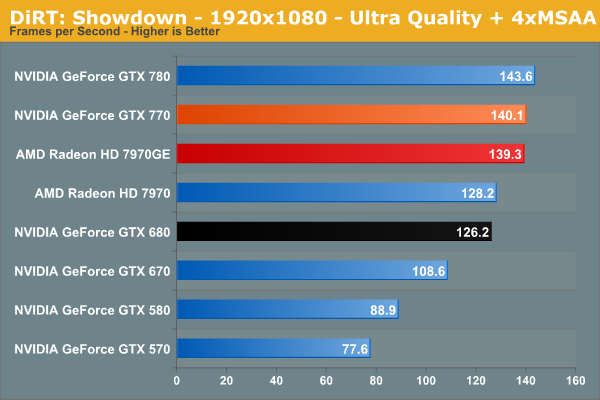NVIDIA GeForce GTX 770 Review: The $400 Fight
by Ryan Smith on May 30, 2013 9:00 AM ESTDiRT: Showdown
As always, starting off our benchmark collection is our racing benchmark, DiRT: Showdown. DiRT: Showdown is based on the latest iteration of Codemasters’ EGO engine, which has continually evolved over the years to add more advanced rendering features. It was one of the first games to implement tessellation, and also one of the first games to implement a DirectCompute based forward-rendering compatible lighting system. At the same time as Codemasters is by far the most prevalent PC racing developers, it’s also a good proxy for some of the other racing games on the market like F1 and GRID.



Despite the fact that it’s a $400 card, GTX 770 straddles the line between being a card best suited for 2560x1440, and a card best suited for 1920x1080. With GTX 780 and above we could get away with 2560 on the highest settings in most games, but with GTX 770 there will at times be compromises, either in quality/resolution, or dropping below 60fps.
In any case, DiRT: Showdown remains a troublesome title for NVIDIA. With its advanced lighting system on, GTX 770 trails the 7970 – let alone the 7970GE – at every resolution. For GTX 780 this wasn’t a problem, but for GTX 770 this means dropping below 60fps at 2560.










117 Comments
View All Comments
khanov - Friday, May 31, 2013 - link
*sigh*You failed again.
khanov - Friday, May 31, 2013 - link
Sorry dude, that wasn't aimed at you. Anand your comments system has a mind of its own.If I reply to xyz I sort of expect my reply to be below xyz's comment and not inserted randomly in to the comments list.
chizow - Thursday, May 30, 2013 - link
Once again, a year late, but still a nice card. The updated cooler and higher memory clocks are impressive, but the max Boost clock was achievable on "FTW" type binned GTX 680s in the past.I guess this is Nvidia's "Gigahertz Edition", basically an overclocked SKU to bring parity in the performance midrange market.
Homeles - Thursday, May 30, 2013 - link
How in the world is this card a year late? Nvidia was still winning at this time, one year ago. Now they have not one, not two, but three single GPU cards that are on parity or are faster than the 7970 GE. Nvidia is in a far better position than they were with their GTX 500 series.chizow - Thursday, May 30, 2013 - link
Full GK104 should've been GTX 670 and below from the outset, as Nvidia initially planned. That's why it's a year late, at this price point anyways.Also, AMD reached parity with Nvidia's GTX 680 last year with the 7970GE launch in June/July, which then distanced itself by 5-10% with the Never Settle Drivers in Sept/Oct last year.
Now that the GTX 770 has launched and is ~10% faster than the 680, it again, reaches parity with the 7970GE.
JPForums - Thursday, May 30, 2013 - link
I thought the 104/114 series was historically reserved for the x60, while the 100/110 series was meant for the x70/x80 chips. Thus this new highend GK104 model should have been a 760Ti. GK110 should have maxed out at the 780 and the 770 should have been the paired down model. If they really had to have a Titan, it should have been a DPFP uncapped 780 (so they got that almost right).Of course the prices should have been the usual highend price points and not the massive price jumps they are currently pushing. Sure you can justify the price with the current performance relative to the previous generation, but if we always did that, the high end cards would get perpetually more expensive as the performance of each new generation of cards would justify a price hike over the previous generation. In reality, these prices are the unfortunate result of a lack of competition. Of course not all companies handle lack of competition the same way. nVidia has shown that, when uncontested, they will jack introductory prices into the stratosphere (8800 Ultra - $800-1000, $650 - GTX280, Titan/GTX780 - $1000/$650). Under normal competitive conditions, the top single GPU card from either nVidia or AMD/ATi of each generation comes in at $500. In similarly uncontested situations AMD/ATi has proven to be much less abusive to their customers (7970 - $550, 5870 - $400). Granted the relatively low price of the Dual GPU GTX295 probably kept the 5870s price in check until the GTX400 series launched, but at that point there was a significant difference in stability between single and dual GPU cards. Now I must mention, lest anyone gets the wrong idea, that AMD/ATi was probably only taking this route because marketshare/mindshare was more important to them than profit margins. Nonetheless, the facts remain.
chizow - Thursday, May 30, 2013 - link
I agree with virtually everything you said, although I never really had a problem with Nvidia jumping GK104 up a SKU to the x70 range. The performance was certainly there especially relative to last-gen performance and full GK104 also beat AMD's best offering at the time.The problem I had was Nvidia's decision to turn this 2nd tier ASIC into their flagship and subsequently, hold off on launching their true flagship ASIC a full year AND charge $1000 (and later, $650) for it.
All events predicated on the fact AMD launched 7970 at flagship prices when it really didn't deserve the asking price. Tahiti launch set the stage for Nvidia to not only undercut AMD pricing but to beat them in performance as well with only their 2nd tier chip.
JPForums - Thursday, May 30, 2013 - link
True, the 7970 could definitely be considered overpriced when it launched, but it was the undisputed performance champ until nVidia finally launched the GTX680 to bring back competition. Though, this begs the question, was the 7970 really this underperforming, or was the GK104 simply larger and faster (relatively speaking) than midrange chips in the past. Given that the GK104 die size is smaller than the GTS250, GTX460, GTX555 die sizes, I'd say larger is out. That said, they removed a lot of compute resources to get the gaming performance they were targeting, so faster might hold some weight.The 7000 series sudden proficiency in compute combined with the equally sudden removal of compute focus in the GTX600 series meant the 7970 would need to be far larger to maintain equivalent performance. Given the fact that Tahiti XT (352mm) was much closer to the size of GK104 (294mm) than GK110 (561mm), the 7970 should probably be considered a mid-weight. That is to say I can conclude that Tahiti XT was under performing (in games) AND GK104 was an overachiever. So the question becomes, is compute capabilities important enough to sacrifice gaming performance that a year ago likely would have clocked in closer to the GTX780 (GTX775 class?) for compute performance that in many cases exceeds Titan, but gaming performance roughly on par with a GTX680?
JlHADJOE - Friday, May 31, 2013 - link
IMO AMD's initial, higher price on the 7970 was justified. People forget that it was a much bigger chip than the 6970, with a 384-bit bus instead of 256. Any 384-bit part is effectively big, IMO. Same size as the 580, and now the Titan and 780.The fault here IMO goes right back to AMD's marketing division. If they hadn't stupidly went from 5870 to 6970, then people might have noticed that Tahiti was in fact a bigger part than its two immediate predecessors, and properly deserving of the 7900-series naming.
EJS1980 - Thursday, May 30, 2013 - link
Pretty much this /I\I
I